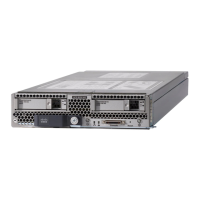Enabling the Trusted Platform Module
The Trusted Platform Module (TPM) is a component that can securely store artifacts used to authenticate the
server. These artifacts can include passwords, certificates, or encryption keys. A TPM can also be used to
store platform measurements that help ensure that the platform remains trustworthy. Authentication (ensuring
that the platform can prove that it is what it claims to be) and attestation (a process helping to prove that a
platform is trustworthy and has not been breached) are necessary steps to ensure safer computing in all
environments. It is a requirement for the Intel Trusted Execution Technology (TXT) security feature, which
must be enabled in the BIOS settings for a server equipped with a TPM.
Procedure
Step 1
Install the TPM hardware.
a) Power off, decommission, and remove the blade server from the chassis.
b) Remove the top cover from the server as described in Removing a Blade Server Cover, on page 13.
c) Install the TPM to the TPM socket on the server motherboard and secure it using the one-way screw that
is provided. See the figure below for the location of the TPM socket.
d) Return the blade server to the chassis, power it on, and allow it to be automatically reacknowledged,
reassociated, and recommissioned.
e) Continue with enabling TPM support in the server BIOS in the next step.
Figure 25: TPM Socket Location
TPM socket on motherboard2Front of server1
Step 2
Enable TPM Support in the BIOS.
a) In the Cisco UCS Manager Navigation pane, click the Servers tab.
b) On the Servers tab, expand Servers > Policies.
Cisco UCS B200 M5 Blade Server Installation and Service Note
49
Servicing a Blade Server
Enabling the Trusted Platform Module

